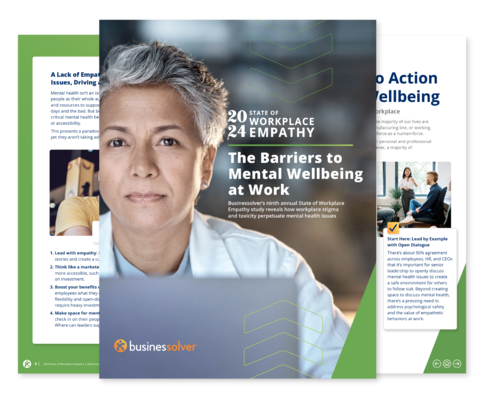Businessolver’s 2024 Mental Health Report highlights critical barriers to workplace mental health and 70-point gaps between the mental health benefits employees say are important and those they actually use
-

Businessolver’s ninth State of Workplace Empathy study uncovers the barriers to mental wellbeing in the workplace. (Photo: Business Wire)
DENVER–(BUSINESS WIRE)–Businessolver, a leader in benefits and HR technology solutions, today released “Barriers to Mental Wellbeing at Work,” a detailed look at the current state of mental health in the workplace. The report is based on findings from its 2024 State of Workplace Empathy Study, now in its ninth year.
This year’s study revealed a marked increase in reported mental health issues and workplace toxicity across a national sample of CEO, HR professionals, and employee respondents. Among the notable findings, 55% of CEOs and 50% of employees reported mental health issues in the last year, a 24-point increase over 2023 for CEOs. Additionally, 52% of CEOs and 32% of employees cite toxic company cultures.
Stigmas and Workplace Toxicity Are Undermining Mental Wellbeing
While mental health issues are widespread, women, younger generations, disabled, veterans, caregivers, and LGBTQ+ employee populations are 10 to 27 points more likely to cite a mental health issue within the past year than the average employee. The study also found a strong mental health stigma transcends audiences: CEOs (81%), HR (72%), and employees (67%) all agree that companies view someone with mental health issues as weak or a burden.
Workplace toxicity and difficulty displaying empathy are likewise key challenges perpetuating mental health issues. Findings suggest a strong association exists between workplace toxicity and mental health issues: Employees who said their workplace is toxic are 47% more likely to cite a mental health issue compared to those who do not cite a toxic workplace—this is even higher for CEOs at 64%. Other key findings include:
- CEOs (52%), Gen Z (65%), veterans (63%), and disabled/neurodiverse (52%) are most likely to cite toxic workplaces.
- Hispanic (56%) and Asian (48%) respondents are more likely than other ethnicities to say their company culture is toxic and significantly more likely to agree that companies consider those with mental health issues weak or a burden—80% and 76% respectively.
- 63% of CEOs, 47% of HR professionals, and 42% of employees feel they’ll be challenged or viewed as weak for demonstrating empathy at work. For all audiences, concerns range from not being supported by peers, losing respect, and feeling too busy.
“This year’s mental health and toxicity data underscores the urgent need for employers to prioritize a supportive and stigma-free workplace,” said Rae Shanahan, Businessolver’s Chief Strategy Officer. “I’ve shared my own mental health journey and understand the challenges others face. Employers alone can’t ensure someone’s mental health, but they can create a supportive, empathetic environment where team members feel comfortable seeking help and receiving the support they need.”
Despite widespread stigma and workplace toxicity, however, 73% of employees believe their manager emphasizes the importance of mental health along with 83% of HR and 92% of CEOs. There’s a likewise positive trend in workplace connections with 87% of employees feeling comfortable providing emotional support to coworkers and 86% feeling comfortable offering guidance and advice.
70-Point Gaps Exist Between the Mental Health Benefits Employees Rate Highly Important and Those They Use
While many employers have increased mental health support since the pandemic, Businessolver’s data shows employees are not using the mental health benefits they rate as highly important. On average, 70-point gaps exist between the mental health benefits employees say are important and those they actually use.
Whether due to lack of awareness, accessibility, stigma, or otherwise, employees are less likely to use employer-sponsored programs and benefits that explicitly address mental health, such as Employee Assistance Programs (EAPs), even though they are rated as highly important. Instead, employees cite family (40%) and friends (33%) as their primary sources of mental health support. Only 11% of employees, 8% of HR, and 15% of CEOs say they have used a mental health professional or employee-sponsored benefit or resource.
The top benefits and resources employees said help them care for their mental health include open-door policies, mental health benefits, EAPs, flexible work hours, virtual mental health resources, breaks away from work, and remote work.
“Employees are signaling loud and clear that flexibility in all its evolving forms is a critical aspect of supporting mental wellbeing,” said Shanahan. “Equally important, however, is the role employers play in driving awareness for and access to these critical benefits. We know from our platform data that technology and personalized communications can double benefits engagement rates by meeting employees where, when, and how they want to be met in their moments of need.”



